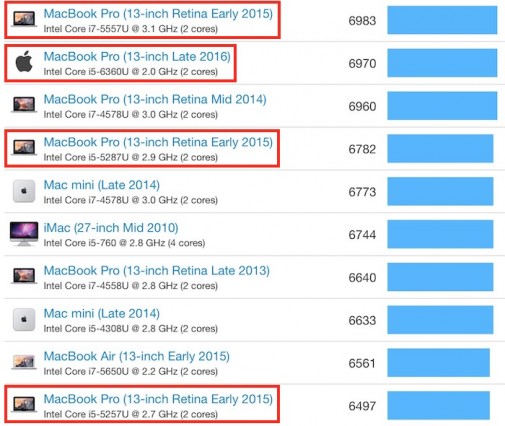
- #2015 macbook pro 13 2.7 geekbench mac os x#
- #2015 macbook pro 13 2.7 geekbench 1080p#
- #2015 macbook pro 13 2.7 geekbench install#
- #2015 macbook pro 13 2.7 geekbench upgrade#
- #2015 macbook pro 13 2.7 geekbench pro#
If you're not completely convinced that Apple is the way to go then check out some alternatives in our regularly-updated Best Laptops and buying guide. The price premium over similarly specified Windows laptops is vast, but if you can afford it, the superior build quality, great OS and incredible battery life are worth it.
#2015 macbook pro 13 2.7 geekbench upgrade#
A better processor, battery life, faster storage and a Force Touch touchpad make it a worthwhile upgrade for those using almost any non-Retina MacBook Pro.
#2015 macbook pro 13 2.7 geekbench pro#
The 13-inch MacBook Pro with Retina Display isn't a major leap forward in technology, but it didn't need to be.

Capacity is tight at 256GB on our model, so if you opt not to upgrade to a 512GB or 1TB SSD at purchase you'll need Thunderbolt-based external hard disks to store large video files or photo libraries. This contributes to the MacBook Pro's zippy performance, too. We saw write speeds of 1200MB/s and read speeds of 1251MB/s in the Blackmagic SSD benchmark massive increase from last year's sub-700MB/s results. The 2015 MacBook Pro also gains faster PCI-E-based flash storage. For everything but the toughest of tasks, though, the MacBook Pro remains cool and quiet. When pushed hard, the laptop's fans begin to whir and the upper section of the keyboard tray get very hot, becoming almost painful to touch.
#2015 macbook pro 13 2.7 geekbench install#
The on-board Intel Iris 6100 graphics are also surprisingly capable we ran our standard Dirt Showdown benchmark (via a Windows 8 install using Boot Camp) and were impressed with the 33.5fps the laptop was able to produce. Indeed, this year's MacBook Pro took 12h 7m to deplete – an almost three hour improvement over the previous generation model. It's a small performance bump over last year's model, but Broadwell was designed with lower power consumption in mind rather than raw speed. In our new benchmarks, it scored a hugely impressive 87 in the image editing test, with scores of 60 and 43 in the video editing and multitasking challenges giving it an overall score of 56.

Things slow a little when it comes to more advanced multimedia tasks, but it's still very capable.
#2015 macbook pro 13 2.7 geekbench mac os x#
Performance is as snappy as you'd expect, helped by the cohesive feel of the Mac OS X operating system that helps you work through tasks at a blazing pace. The 15' Retina MacBook Pro still feels like a holdover from the 'Mac tax' days, where you paid more simply to get a Mac.
#2015 macbook pro 13 2.7 geekbench 1080p#
We tested the base model, which has a dual-core Core i5-5257U running at 2.7GHz. The 13' MacBook Pro with Retina display is actually nicely priced for what you get, and it competes well with 1080p and 2K Windows Ultrabooks that run on slower and lower watt ULV CPUs.

Apple also connects the LPDDR4X-4266 memory tightly and efficiently to the SoC, which significantly increases the bandwidth compared to the classic use in DRAM modules.The second significant change is the switch to fifth-generation Intel "Broadwell" processors. This is impressive, but is also due to the fact that the iGPU of the Intel Core i5-1038NG7 is still manufactured in a 14 nm process (the processor itself is already manufactured in 10 nm), while the Apple M1 is manufactured entirely in 5 nm at TSMC. The iGPU (internal graphics unit) of the Apple M1 beats the Intel Iris Plus Graphics (Ice Lake G7) by a factor of 2.5 in FP32 calculations (single precision). In addition, the new AV1 video codec is decoded in hardware, which can benefit the energy consumption and thus also the battery life in a notebook. Apple has given the M1 16 special cores that can be used to calculate machine learning. Active cooling has advantages in long load phases, during which the passively cooled Apple M1 throttles down to 10 watts of power loss after a certain period of time. The Apple M1 can be used passively cooled (Apple Macbook Air 2020) or actively cooled (Apple Macbook Pro 2020 or Apple mac mini 2020).

The chips couldn't be more different in detail: Apple already relies on the big.LITTLE principle, in which small and efficient CPU cores are paired with fast performance cores, all 4 cores in the Intel processor are identical. The raw performance per clock in the Apple M1 is enormously better than in the Intel Core i5-1038NG7, because the latter clocks its cores with up to 3.8 GHz, while the M1 is clocked with a maximum of 3.2 GHz. 25% faster in the single core and 35% faster in the multi-core benchmark. The most objective is currently the Cinebench R23, in which the Apple M1 is approx. Because Intel's 28 watt CPU is sometimes clearly beaten in comparison with the Apple M1 processor, which operates at a maximum of 15 watts. A direct comparison of the Apple M1 with the Intel Core i5-1038NG7 shows that the praise is well justified. In the press, Apple's new M1 processor is covered with praise.


 0 kommentar(er)
0 kommentar(er)
